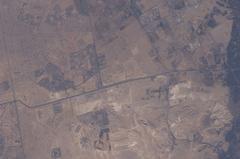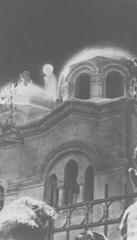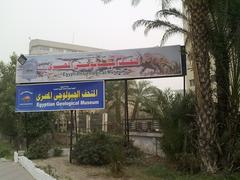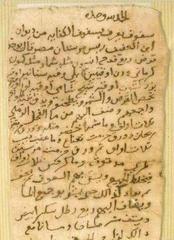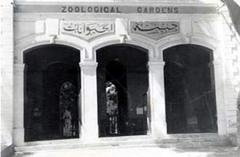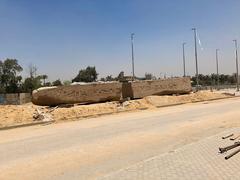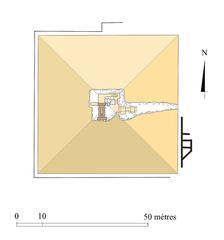
Lepsius-I Pyramid Visiting Hours, Tickets, and Historical Information in Giza Governorate, Egypt
Date: 03/07/2025
Introduction to the Lepsius-I Pyramid
Table of Contents
- Introduction
- Historical Background
- Architectural Features and Preservation
- Archaeological and Cultural Significance
- Visiting the Lepsius-I Pyramid
- Nearby Attractions
- Site Etiquette and Responsible Tourism
- What to Expect During Your Visit
- Facilities and Practical Tips
- Booking and Planning
- Emergency Contacts
- FAQ
- Visuals and Interactive Resources
- Related Articles
- Conclusion
- References
Historical Background
Early Exploration and the Lepsius Expedition
The Lepsius-I Pyramid derives its name from Karl Richard Lepsius, a pioneering German Egyptologist whose expedition (1842–1846) marked the first systematic survey of Egypt’s pyramids. Lepsius and his team catalogued 67 pyramids and over 130 tombs, famously designating the Abu Rawash monument as “Lepsius No. 1” due to its location at the northern edge of the pyramid field (Springer, 2020). His meticulous documentation, including architectural drawings and early photographs, established standards for modern archaeological research.
Structure, Materials, and Location
Situated on a plateau at Abu Rawash (GPS: 30.04083°N, 31.09444°E), the Lepsius-I Pyramid overlooks the Nile Valley, offering panoramic views of the surrounding landscape. The monument was constructed mainly from mudbrick and local limestone, which has contributed to its degraded state. The core masonry rises about nine meters today, though its original height and base remain subjects of scholarly debate. The internal structure features a descending corridor leading to a square burial chamber, distinguishing it from other contemporary pyramids.
Chronological Context and Attribution
The pyramid’s precise builder remains uncertain. Theories have ranged from Djer (First Dynasty) to Huni (late Third Dynasty), with some evidence suggesting connections to the Fourth Dynasty due to the proximity of mastaba tombs and the neighboring pyramid of Djedefre. This ambiguity highlights the transitional nature of the site and the ongoing evolution of pyramid construction in ancient Egypt.
Architectural Features and State of Preservation
The Lepsius-I Pyramid is smaller and less well-preserved than its famous Giza counterparts. Its rougher masonry and modest size (base approximately 31 meters) suggest it may have served as a subsidiary structure, perhaps for a queen or a high-ranking noble (Tripsavvy). The pyramid’s alignment with the cardinal points reflects the religious and cosmological significance placed on orientation in ancient Egyptian architecture. Despite its ruined appearance, the site holds considerable archaeological value, offering insights into early pyramid-building experiments and the broader Giza necropolis layout (The Tourist Checklist).
Archaeological and Cultural Significance
Early Experimentation in Pyramid Construction
The Lepsius-I Pyramid reflects a period of architectural experimentation during the late Third and early Fourth Dynasties. It represents a transitional phase between the step pyramids of Saqqara and the smooth-sided pyramids of Giza, providing valuable information on construction techniques and evolving funerary practices (Rost Architects, 2025).
Contribution to Egyptology
Lepsius’s rigorous documentation of the pyramid and surrounding necropolis was a milestone in scientific Egyptology, emphasizing the importance of preserving Egypt’s monumental heritage (Springer, 2020). His methods influenced generations of researchers and established the pyramid as a symbol of both ancient innovation and modern scholarship.
Modern Research and Discoveries
Recent investigations, including ground-penetrating radar and advanced imaging, have renewed interest in Abu Rawash and the Lepsius-I Pyramid. Ongoing archaeological missions are anticipated to reveal further insights into the site’s function and chronology (Egypt Independent, 2025).
Symbolic and Ritual Importance
As with other Egyptian pyramids, the Lepsius-I Pyramid was conceived as a monument aiding the pharaoh’s journey to the afterlife, embodying religious and cosmological symbolism (Rost Architects, 2025). Its placement on an elevated plateau reinforces its spiritual and visual significance within the necropolis (Pyramids of Giza).
Visiting the Lepsius-I Pyramid
Visiting Hours and Tickets
- Opening Hours: 8:00 am – 4:00 pm (October–March); 8:00 am – 5:00 pm (April–September) (The Intrepid Guide).
- Ticket Price: General Giza Plateau ticket (includes Lepsius-I Pyramid) – 120 EGP for adults, 60 EGP for students with valid ID (The Intrepid Guide). Additional fees apply for entry into the main pyramids; Lepsius-I access is included.
- Purchase: Buy tickets at official counters (credit cards accepted), or book online to avoid queues (Nile Empire).
- Discounts: Half-price for children under 12 and ISIC cardholders (Egypt Tailor Made).
Check the Ministry of Tourism website for updates on conservation closures or special events.
Getting There and Accessibility
- Location: Northern edge of the Giza Plateau, Giza Governorate, approximately 15 km southwest of central Cairo.
- Transport:
- Metro (Line 2) to Giza station, then taxi or ride-share.
- Shuttle buses operate within the plateau, connecting major sites, including the Lepsius-I Pyramid (KosupaTravel).
- Taxi, Uber, and Careem are widely available.
- Parking: Expanded, paved parking areas near the new main entrance (Lanera360).
- Accessibility: Newly paved, wheelchair-friendly paths link the entrance with major monuments; shuttle buses assist visitors with mobility needs.
Guided Tours and Photography
- Guided Tours: Highly recommended for historical context; arrange in advance or at the entrance (Nile Empire).
- Audio Guides: Available in multiple languages.
- Photography: Permitted in open areas. Drones are prohibited; flash and tripods may be restricted in certain zones.
Nearby Attractions
- Pyramid of Djedefre: Adjacent to Lepsius-I, offering insights into Fourth Dynasty royal tombs.
- Great Pyramid of Khufu, Khafre, and Menkaure: The main pyramids of Giza, a short drive south.
- Solar Boat Museum: Home to a reconstructed ancient boat discovered near the Great Pyramid.
- Mastaba Tombs: Explore nearby elite burials for a deeper understanding of Old Kingdom funerary culture (The Tourist Checklist).
Site Etiquette and Responsible Tourism
- Dress Code: Modest attire recommended; shoulders and knees covered (Nile Empire).
- Respect the Site: Climbing or defacing monuments is strictly prohibited; stay on marked paths and do not remove stones (Traveler Bibles).
- Photography: Always ask before photographing site staff or other visitors.
- Vendors: Only use clearly identified official guides and services; politely decline persistent vendors.
- Environmental Care: Leave no litter and avoid disturbing wildlife.
What to Expect During Your Visit
- Atmosphere: The Lepsius-I Pyramid area is typically quieter than the main pyramids, offering a more contemplative experience.
- Terrain: Uneven, sandy, and rocky—sturdy footwear is essential. Wheelchair and stroller access is best along the new paved routes.
- Weather: Hot and dry, especially in summer. Wear sun protection and bring plenty of water (Kimkim).
- Facilities:
- Restrooms and shaded seating at the main entrance and along visitor routes.
- Dining at the 9 Pyramids Lounge, with panoramic views (Lanera360).
- Official souvenir shops are available.
Practical Tips
- Hydration: Carry 1–2 liters of water per person.
- Best Times: Early morning or late afternoon for cooler weather and optimal photography.
- Time Allocation: Allow 4–5 hours to explore the plateau, including the Lepsius-I Pyramid (The Intrepid Guide).
- Children: The site is family-friendly, but close supervision is advised.
Booking and Planning
- Advance Tickets: Buy online via the official portal for preferred time slots.
- Groups: Group tours offer discounts and streamlined entry.
- Special Needs: Contact the site in advance for assistance.
Emergency Contacts
- Help Desks: Located at the main entrance and shuttle stops.
- Police: Dial 122
- Medical Aid: Dial 123
FAQ
Q: What are the Lepsius-I Pyramid visiting hours?
A: Generally, 8:00 am – 4:00 pm (October–March); 8:00 am – 5:00 pm (April–September).
Q: How do I purchase tickets?
A: Buy at official counters (credit card accepted) or online via the Ministry of Tourism.
Q: Is the site wheelchair accessible?
A: Yes, with new paved paths and shuttle services.
Q: Can I take photos?
A: Yes, in open areas. Drones are prohibited.
Q: Are guided tours available?
A: Yes, through licensed guides booked in advance or at the entrance.
Visuals and Interactive Resources
Alt text: Lepsius-I Pyramid on the northern edge of the Giza Plateau, Egypt.
Alt text: Map highlighting the location of the Lepsius-I Pyramid among Giza historical sites.
Explore virtual tours and interactive maps on our website for an immersive planning experience.
Related Articles
- Guide to Visiting the Great Pyramid of Khufu
- Exploring the Solar Boat Museum at Giza
- Saqqara: The Step Pyramid of Djoser Travel Tips
Conclusion
The Lepsius-I Pyramid is a hidden gem on the Giza Plateau, offering a peaceful escape from the crowds and a unique window into Egypt’s architectural and cultural evolution. Recent improvements in visitor infrastructure have made the site more accessible while helping preserve its fragile remains. By planning ahead, respecting site etiquette, and embracing responsible tourism, you can enjoy a meaningful and memorable journey into Egypt’s ancient heritage. For more tips, interactive guides, and updates, download the Audiala app and follow us on social media.










